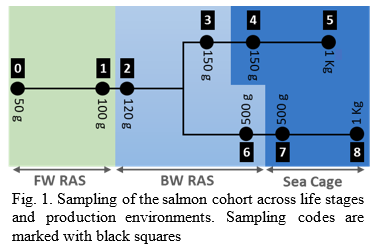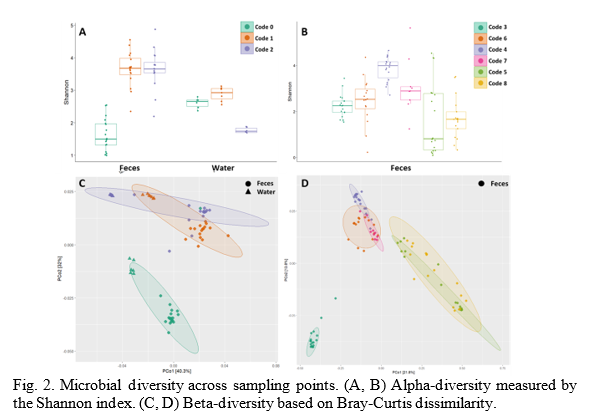EFFECT OF RAS ON ATLANTIC SALMON GUT MICROBIOME AND ITS INTERACTION WITH PERFORMANCE AFTER SEAWATER TRANSFER
Introduction
Recirculating Aquaculture Systems (RAS) are increasingly common land-based production systems, however, biological requirements of the fish are not always considered, contributing to the high mortalities observed, notably following the seawater transfer (SWT) . SWT is a challenging production phase associated with stress, impaired welfare, and elevated susceptibility to opportunistic infections (Sommerset et al., 2023). The gut microbiome plays an array of critical roles in fish biology, not only during digestion but also in the immune and barrier functions with large implications for the fish’s health. Importantly, little work has been conducted to investigate how farming procedures can alter the fish’ microbiome and the health of the holobiont. This study aims to characterize the effects of different RAS protocols ( size at SWT) on gut microbiome , in relatio n to fish health and welfare.
Materials and methods
A fish cohort from a commercial production facility was monitored from the parr stage in freshwater (FW) RAS through transfer to brackish water (BW) RAS. T wo transfer strategies were applied: release of small (150 g) or large (500 g) smolts to sea cages (SC). Sampling points are depicted in Fig. 1 and were as follows: A) FW RAS: parr at 50 g ( Code 0) and 100 g just before transfer to BW ( Code 1) ; B) BW RAS: one week after transfer ( Code 2) and just before seawater transfer (SWT) at either 100 g ( Code 3) or 500 g ( Code 6); and C) SC: at one week ( Codes 4 & 7) and six months after SWT ( Codes 5 & 8). Fish weight and somatic indexes were recorded. Three sample sets were collected: plasma for general welfare assessments and water and feces for microbiome analysis. F eces were collected from the posterior intestine. Total genomic DNA was extracted for metataxonomic, DNA amplicon libraries were generated targeting the V3-V4 regions (341F/R805) of the 16S rRNA gene, and the sequencing was performed on the Illumina platform. Analysis of the sequences was performed following standards pipelines for metataxonomic analysis. Clean sequences chimeric detection and deletion, followed by Amplicon Sequence Variant (ASV) assignment was completed using the DADA2 plugin. Taxonomy was assigned with a 99% similarity level using the q2-feature-classifier plugin with the SILVA138 database. Alpha (Shannon) and beta (Bray Curtis) diversity indices were calculated using the vegan R package.
Results
Alpha-diversity was low in the salmon gut microbiota at the early parr stage (Code 0) (Fig. 2A) and closely resembled the RAS water, being largely dominated by Aurantimicrobium (data not shown). From the smolt stage onwards (Code 1), the microbiota became more diverse and increasingly distinct from the surrounding water , despite the BW being less diverse than the FW. Beta-diversity revealed significant differences among Codes 0, 1, and 2, with the most pronounced difference observed between Codes 1 and 2 (Fig. 2C).
In the remaining samples, alpha-diversity was significantly different between salmon gut microbiota one week after SWT in fish transferred at 150 g and 500 g (Codes 4 and 7; Fig. 2B). According to beta-diversity analysis, significant differences existed between small and large smolts during the BW phase (Codes 3 and 6; Fig. 2D). SWT of smaller fish was associated with higher gut microbiota diversity compared to fish transferred at bigger size . Gut microbiome differences were most pronounced one week after sea transfer (Codes 4 and 7). By the end of the sea- cage phase (Codes 5 and 8), differences were less marked but remained significant (Fig. 2D) with Mycoplasma emerging as the dominant genus (data not shown). Correlation analysis between gut microbiota and fish weight revealed significant associations, particularly in the cohort transferred at smaller size (data not shown) . Most correlations were positive (e.g., Prochlorococcus , Aeriscardovia , and Mycoplasma ), while a few were negative (e.g., Francisella). Correlation with other biological aspects is in progress and will be updated at a later stage before the presentation.
Discussion and conclusion
Our findings show that the salmon gut microbiota gradually diverges from the surrounding environment and becomes specialized over time. Although gut communities converged by the end of the sea production cycle, differences in body weight at SWT appear to shape microbial composition of the early SW phase, likely contributing to the heightened vulnerability and mortality often observed at this stage. Notably, the association between microbiota profiles and fish size at SWT suggests a potential link to performance. Further research is needed to clarify how microbial shifts over time relate to other biological factors. Overall, our results highlight life stage–dependent changes in gut microbiome and suggest functional relevance, an area still underexplored in fish microbiome research.
References
Sommerset et al., Fiskehelserapporten 202 . ISBN ISBN 1893-1480
Acknowledgments
This project has been funded by BlueRemediomics -Grant No.101082304, Horizon Europe Programme 2022. Fish were sampled from Lerøy´s land and sea facilities in Norway.

